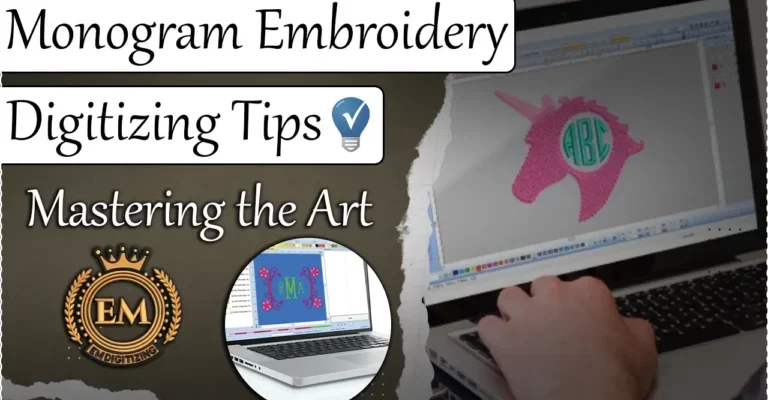
Embroidery has long been cherished for its ability to add a personal touch to textiles, and monogram embroidery takes this customization to the next level. Whether you’re embroidering initials on towels, linens, or clothing, mastering the art of monogram embroidery digitizing is essential for achieving professional results. In this comprehensive guide, we’ll delve into essential tips to help you excel in monogram embroidery digitizing. Additionally, we’ll explore the role of embroidery digitizing services in enhancing your projects and answer frequently asked questions to deepen your understanding of this intricate craft.
Understanding Monogram Embroidery Digitizing
Monogram digitizing for embroidery involves converting initials or designs into digital formats that embroidery machines can interpret. This process requires precision and attention to detail to ensure that the final embroidered monogram is crisp and visually appealing.
1. Choosing the Right Font
The font style plays a crucial role in monogram embroidery. Selecting a font that complements the intended application is essential. Fonts with clear lines and defined edges translate well into embroidery, ensuring legibility and aesthetic appeal.
2. Simplifying Design Elements
When digitizing monograms, simplify intricate design elements to ensure clarity in embroidery. Too many details can diminish the readability of the monogram when stitched. Clean lines and well-defined shapes are key to achieving a polished result.
3. Understanding Stitch Types
Different stitch types can enhance the appearance and texture of monogram embroidery. Satin stitches are commonly used for outlining letters due to their smooth and shiny finish, while fill stitches can be employed for larger areas to provide depth and richness.
4. Adjusting Density and Stitch Length
Density refers to the number of stitches within a specific area of the design. Optimal density ensures that the fabric is adequately covered without puckering or distortion. Adjusting stitch length and density settings in your embroidery software can fine-tune the appearance of the monogram.
5. Incorporating Underlay Stitches
Underlay stitches are foundational stitches placed beneath the top layers of embroidery. They provide stability to the fabric and prevent it from shifting during stitching. Using appropriate underlay stitches can significantly improve the quality and durability of embroidered monograms.
6. Color Selection
Choosing the right thread colors is crucial for achieving contrast and visibility in monogram embroidery. Consider the background fabric color and the intended use of the embroidered item when selecting thread colors. High-quality embroidery thread ensures vibrant and long-lasting results.
7. Testing and Refining
Before embroidering the final monogram, conduct test runs on similar fabric and settings to ensure the design translates well onto the material. Use these test samples to refine settings such as thread tension, stitch density, and color combinations for optimal results.
8. Utilizing Embroidery Digitizing Software
Investing in embroidery digitizing software can streamline the design process and provide advanced tools for creating and editing monograms. These software programs offer features like automatic digitizing, lettering options, and simulation tools to visualize the final embroidery.
The Role of Embroidery Digitizing Services
Embroidery digitizing services play a pivotal role in ensuring the quality and precision of monogram embroidery. These services employ skilled digitizers who specialize in transforming artwork into digitized files optimized for embroidery machines. By outsourcing digitizing tasks to professionals, individuals and businesses can focus on creativity and production while ensuring consistent and high-quality results.
Advantages of Using Embroidery Digitizing Services
1. Expertise and Experience: Professional digitizers have extensive experience in handling various types of designs and materials, ensuring accurate and efficient digitization.
2. Customization Options: Digitizing services offer customization options to tailor designs according to specific preferences, including font styles, sizes, and color schemes.
3. Time and Cost Efficiency: Outsourcing digitizing tasks saves time and reduces costs associated with trial and error in digitization processes. It allows businesses to meet deadlines and maintain competitive pricing.
4. Quality Assurance: Digitizing services adhere to industry standards and employ quality control measures to deliver flawless digitized files ready for embroidery.
FAQs
Q1: What is the average turnaround time for embroidery digitizing services?
A: Turnaround times vary depending on the complexity of the design and the service provider. Typically, digitizing services offer turnaround times ranging from 24 hours to several days.
Q2: How can I ensure that my monogram embroidery is durable?
A: Use high-quality embroidery threads and fabrics, and ensure proper stabilization and stitching techniques. Following manufacturer guidelines for care and maintenance also prolongs the lifespan of embroidered items.
Q3: Can I digitize my own monogram designs without professional software?
A: While basic digitizing can be done with entry-level software, achieving professional-quality results often requires advanced features and expertise available in professional embroidery digitizing software.
Q4: What are the common file formats used in embroidery digitizing?
A: Popular file formats include DST, PES, and EXP, among others. These formats are compatible with most embroidery machines and ensure accurate reproduction of designs.
Q5: How do I choose the right embroidery digitizing service for my needs?
A: Consider factors such as experience, customer reviews, turnaround times, pricing, and customization options when selecting an embroidery digitizing service. Requesting samples of previous work can also help assess quality and compatibility with your requirements.










